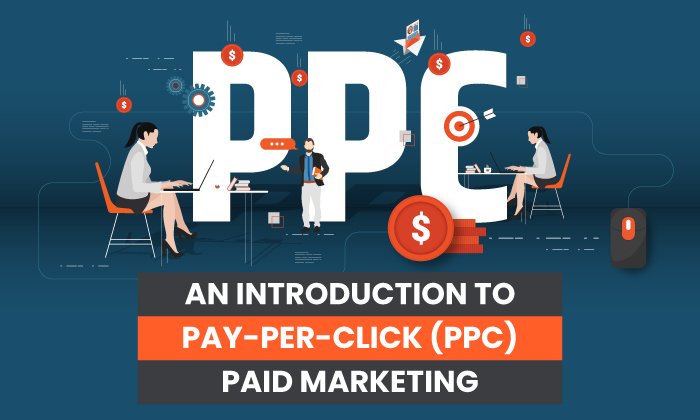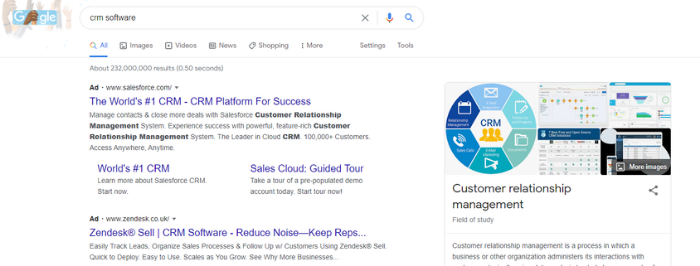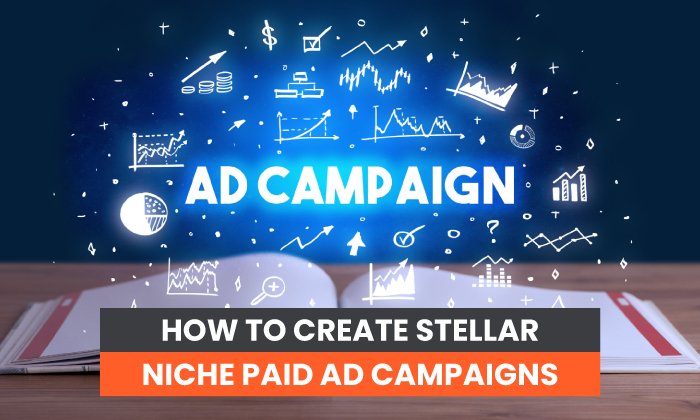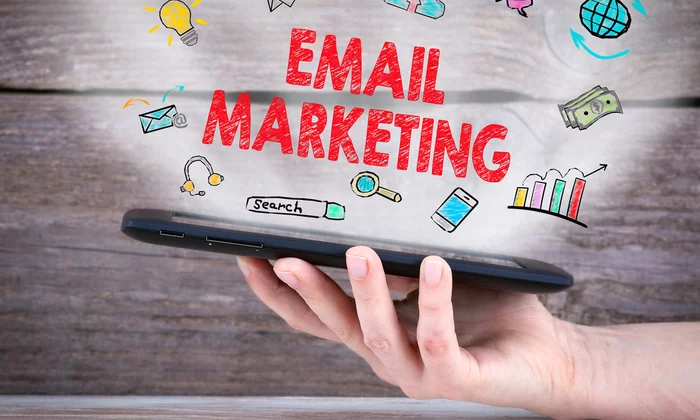MARKETING
An Introduction to Pay-Per-Click (PPC) Paid Marketing

Your brand has the power to reach millions of people around the world, and it only takes a few minutes to do. The power of pay-per-click (PPC) marketing is incredible, with a huge reach and the ability to target specific audiences.
How can you make the most of it?
Investing in PPC can bring a great return for your business (it’s thought paid advertising returns $2 for every $1 invested), but it’s also an easy way to lose money if you don’t approach it in the right way.
To help make sure you’re getting your PPC right, here’s my introduction to pay-per-click marketing.
What is Pay-Per-Click (PPC) Marketing?
Pay-per-click is a common advertising model in internet marketing. It allows advertisers to place ads on search engines, social media platforms, and third-party websites, paying a fee whenever the ad is clicked.

Generating over $134 billion in ad revenue, Google is the largest provider of PPC services. Its platform, Google Ads, is often the first stop for people beginning PPC marketing.
How Much is PPC Advertising?
Whenever you invest in advertising, you want to know how much it’s going to cost you. With PPC, this is a little complicated.
Online advertising isn’t like taking out an ad in a magazine, where you pay a fee and you get a full-cover page. Instead, with PPC, you pay when you get results (someone clicking your ad).
However, with offline advertising, you tend to pay a set fee regardless of the results you achieve. With PPC, you’ve got more control over how much each truly engaged consumer costs you.
This plays out through an auction system. Unlike a traditional auction, though, there isn’t one product with one winner—you’re bidding on how high up and how often your ad could be visible. “Losing” the auction doesn’t necessarily mean you get no PPC space—it means you get less.
Whenever a user searches for a certain keyword, say “PPC Marketing,” Google looks through its list of advertisers for this word and initiates an auction between them. A Google algorithm then chooses ads based on each advertiser’s maximum bid and the quality score of each ad.
The big takeaway from this is that it’s not just about how much you bid. The quality of your ad plays a huge part as well.
That said, if your max bid isn’t realistic, then your ads aren’t going to be shown often enough to be worthwhile. Different keywords have different average costs per click, and this should inform your bidding strategy.
Tools such as Ubersuggest and Google Ads Keyword Planner could give you a good feel for how much your ads are likely to cost, so they should play a role in your keyword research.
Is PPC Marketing Right for My Company?
Like any form of marketing, pay-per-click advertising has its pros and cons. Ideally, your company will use PPC as part of a complete digital marketing strategy, so you maximize its strengths and minimize its weaknesses.
Pros of PPC Marketing
- Immediate results: As soon as your ads are approved, they will reach your target audience.
- Highly targeted: You can be extremely specific about who sees your ads.
- Easy to track: You can quickly track the success of your campaign and measure your ROI.
- Potentially huge exposure: Paid ads are prominently displayed, with the potential to reach a virtually unlimited number of people.
Cons of PPC Marketing
- Costly long-term option: You have to pay for every click, leaving you in the hands of advertising pricing. If you do this for months or years, it’ll add up.
- Not building an asset: When you invest in content marketing or building an email list, you’re creating an asset you own. With PPC, your success is reliant on continued ad spend.
This is why my own digital marketing agency works to create a well-rounded digital marketing plan for your business. PPC has some amazing benefits, but you need good marketing in other areas as well.
PPC isn’t a replacement for organic SEO. The two should complement each other, with organic work taking a good amount of your focus because those clicks are free.
Six Steps to Starting a PPC Marketing Campaign
Starting your first PPC marketing campaign may feel surprisingly simple—you could do it in just six steps. Remember, ad quality plays a large part in your campaign’s success, so make sure you take your time and focus on each step.
1. Figure Out Your PPC Budget
How much do you want to spend on your pay-per-click marketing?
To begin with, you need to set an initial budget to allow you to test the waters. As a rough guide, you can look at some industry benchmarks to understand how much you’re likely to pay for each conversion.
Once you have an overall budget in mind, daily and lifetime spend caps for your campaigns.
This is an important part of creating a PPC campaign because your budget will greatly impact your ads’ success rates. Google Ads gives you good tools to help with this, and it’s worth following Google’s recommendations because its algorithms are designed to maximize your return.
You’ll be able to see an estimate of how many clicks your budget is likely to get you. From there, you can work out your potential return on investment based on your anticipated conversion rate.
If your budget doesn’t allow you to get meaningful results, it might be worth looking at some alternative marketing methods.
2. Set Your Campaign Goals
Different businesses will have different goals for their pay-per-click campaigns.
For example, if you’re doing a pre-launch for a start-up, your goal might be to drive traffic to the site and create awareness. If you’re selling a product, your main goal may be conversions.
The goals you set will have a big impact on your marketing campaign because each goal has a different value. A click isn’t as valuable as a lead or a conversion, and your cost-per-click should reflect this.
Setting up your campaign with the right goals allows you to better target the correct audience and accurately measure your return on investment. You’re paying for the click, not what the customer does afterward, when you use PPC—the click costs the same whether they purchase or not.
Consider who you want to click your ad and what actions you want them to take. When you understand this, optimize your entire campaign to encourage people to take those actions, which should bring down your costs.
3. Figure Out What Type of Campaign to Run
Another element to think about with PPC is what type of campaign you’re going to run. There are lots of options here, each giving you flexibility over how you reach your target audience:
- Search ads: Ads showing at the top of search engines
- Social ads: Ads on social media platforms
- Remarketing ads: Ads that target people who have already visited your website
- E-commerce ads: Ads on Google shopping that are focused on selling products
- Instream ads: Commonly seen on YouTube, played before a video loads
- Display ads: Dynamic ads showing on third-party websites, like in the image below
All these options give you the tools you need to target specific audiences. You need to find out where your audience hangs out and what they respond to. This will change depending on the buyer personas you’re trying to reach.
You don’t have to commit to one particular type of ad, and many businesses find a mix of different ad formats works best for them. However, it’s important to keep your eye on your ROI for each ad type so you can tweak your strategy accordingly.
4. Research Your Keywords
Keywords are one of the main tools you’ll use to target your audience, and your keyword research can make or break your campaign.
While you probably have a reasonable idea of how your customers search for your products or services, you need to narrow them down to those that result in people taking action.
A big part of this is understanding user intent. For example, who is more likely to make a purchase: someone searching “what is SEO?” or someone searching for “best keyword research tool?”
It’s probably the second one because of where that search fits into the buyer’s journey. Where people are in the buyer journey dictates how likely they are to make a purchase, so the keywords you choose need to reflect which stage you’re targeting.
Keywords that attract people who are further along in the buying process will generally cost you more, but they’re also more likely to lead to conversions.
5. Bid On Your Chosen Keywords
Most platforms give you different bidding options based on your goals. With Google Ads, this allows you to optimize for:
- target CPA (cost per action)
- target ROAS (return on ad spend)
- maximize clicks
- maximize conversions
- maximize conversion value
- target impression share

Google will automatically bid on your behalf so it can optimize for your desired goal, but you still have some control over your bid. If you optimize to maximize clicks, for example, you can set a maximum bid. If you maximize for conversions, you can set a target cost per action.
It’s important to remember Google is there to help you get the most out of your ad spend. The algorithms are finely tuned to achieve this. It’s often wise to use Google’s recommendations, especially when starting out.
6. Create Keyword-focused Copy With Unique Landing Pages
Getting people to click your ads is only a small part of what you’re trying to achieve. It’s what happens when people land on your page that’s key.
No matter what your goals are, you need unique, engaging landing pages to achieve them.
Your landing pages need to offer a good user experience and be relevant to the ad the user clicked. People want quick access to the information they’re looking for, and if your landing page isn’t relevant to their keywords, they won’t hesitate to click back to Google.
In short, your PPC landing pages need to be optimized and A/B tested to make sure you’re getting the most out of them.
Conclusion
Pay-per-click advertising is an amazing way to reach a highly-targeted audience quickly. Through platforms such as Google, Bing, Facebook, Instagram, and many more, you can set up paid ads in seconds. Once approved, they could be seen by tens of thousands of people, depending on your budget.
While reaching your target audience is vitally important in marketing, the most important thing is what you do when you have people’s attention. This is why you need to give your paid campaigns the care and attention they need or find a company to do it for you.
When you find the right balance with PPC and have your ads perfectly optimized, it can bring you an excellent return on investment and become a vital part of your digital marketing weaponry.
Is pay-per-click advertising a great earner for your business?
See How My Agency Can Drive Massive Amounts of Traffic to Your Website
- SEO – unlock massive amounts of SEO traffic. See real results.
- Content Marketing – our team creates epic content that will get shared, get links, and attract traffic.
- Paid Media – effective paid strategies with clear ROI.
MARKETING
YouTube Ad Specs, Sizes, and Examples [2024 Update]
![YouTube Ad Specs, Sizes, and Examples [2024 Update] YouTube Ad Specs, Sizes, and Examples](https://articles.entireweb.com/wp-content/uploads/2024/06/YouTube-Ad-Specs-Sizes-and-Examples.jpg)
Introduction
With billions of users each month, YouTube is the world’s second largest search engine and top website for video content. This makes it a great place for advertising. To succeed, advertisers need to follow the correct YouTube ad specifications. These rules help your ad reach more viewers, increasing the chance of gaining new customers and boosting brand awareness.
Types of YouTube Ads
Video Ads
- Description: These play before, during, or after a YouTube video on computers or mobile devices.
- Types:
- In-stream ads: Can be skippable or non-skippable.
- Bumper ads: Non-skippable, short ads that play before, during, or after a video.
Display Ads
- Description: These appear in different spots on YouTube and usually use text or static images.
- Note: YouTube does not support display image ads directly on its app, but these can be targeted to YouTube.com through Google Display Network (GDN).
Companion Banners
- Description: Appears to the right of the YouTube player on desktop.
- Requirement: Must be purchased alongside In-stream ads, Bumper ads, or In-feed ads.
In-feed Ads
- Description: Resemble videos with images, headlines, and text. They link to a public or unlisted YouTube video.
Outstream Ads
- Description: Mobile-only video ads that play outside of YouTube, on websites and apps within the Google video partner network.
Masthead Ads
- Description: Premium, high-visibility banner ads displayed at the top of the YouTube homepage for both desktop and mobile users.
YouTube Ad Specs by Type
Skippable In-stream Video Ads
- Placement: Before, during, or after a YouTube video.
- Resolution:
- Horizontal: 1920 x 1080px
- Vertical: 1080 x 1920px
- Square: 1080 x 1080px
- Aspect Ratio:
- Horizontal: 16:9
- Vertical: 9:16
- Square: 1:1
- Length:
- Awareness: 15-20 seconds
- Consideration: 2-3 minutes
- Action: 15-20 seconds
Non-skippable In-stream Video Ads
- Description: Must be watched completely before the main video.
- Length: 15 seconds (or 20 seconds in certain markets).
- Resolution:
- Horizontal: 1920 x 1080px
- Vertical: 1080 x 1920px
- Square: 1080 x 1080px
- Aspect Ratio:
- Horizontal: 16:9
- Vertical: 9:16
- Square: 1:1
Bumper Ads
- Length: Maximum 6 seconds.
- File Format: MP4, Quicktime, AVI, ASF, Windows Media, or MPEG.
- Resolution:
- Horizontal: 640 x 360px
- Vertical: 480 x 360px
In-feed Ads
- Description: Show alongside YouTube content, like search results or the Home feed.
- Resolution:
- Horizontal: 1920 x 1080px
- Vertical: 1080 x 1920px
- Square: 1080 x 1080px
- Aspect Ratio:
- Horizontal: 16:9
- Square: 1:1
- Length:
- Awareness: 15-20 seconds
- Consideration: 2-3 minutes
- Headline/Description:
- Headline: Up to 2 lines, 40 characters per line
- Description: Up to 2 lines, 35 characters per line
Display Ads
- Description: Static images or animated media that appear on YouTube next to video suggestions, in search results, or on the homepage.
- Image Size: 300×60 pixels.
- File Type: GIF, JPG, PNG.
- File Size: Max 150KB.
- Max Animation Length: 30 seconds.
Outstream Ads
- Description: Mobile-only video ads that appear on websites and apps within the Google video partner network, not on YouTube itself.
- Logo Specs:
- Square: 1:1 (200 x 200px).
- File Type: JPG, GIF, PNG.
- Max Size: 200KB.
Masthead Ads
- Description: High-visibility ads at the top of the YouTube homepage.
- Resolution: 1920 x 1080 or higher.
- File Type: JPG or PNG (without transparency).
Conclusion
YouTube offers a variety of ad formats to reach audiences effectively in 2024. Whether you want to build brand awareness, drive conversions, or target specific demographics, YouTube provides a dynamic platform for your advertising needs. Always follow Google’s advertising policies and the technical ad specs to ensure your ads perform their best. Ready to start using YouTube ads? Contact us today to get started!
MARKETING
Why We Are Always ‘Clicking to Buy’, According to Psychologists

Amazon pillows.
MARKETING
A deeper dive into data, personalization and Copilots

Salesforce launched a collection of new, generative AI-related products at Connections in Chicago this week. They included new Einstein Copilots for marketers and merchants and Einstein Personalization.
To better understand, not only the potential impact of the new products, but the evolving Salesforce architecture, we sat down with Bobby Jania, CMO, Marketing Cloud.
Dig deeper: Salesforce piles on the Einstein Copilots
Salesforce’s evolving architecture
It’s hard to deny that Salesforce likes coming up with new names for platforms and products (what happened to Customer 360?) and this can sometimes make the observer wonder if something is brand new, or old but with a brand new name. In particular, what exactly is Einstein 1 and how is it related to Salesforce Data Cloud?
“Data Cloud is built on the Einstein 1 platform,” Jania explained. “The Einstein 1 platform is our entire Salesforce platform and that includes products like Sales Cloud, Service Cloud — that it includes the original idea of Salesforce not just being in the cloud, but being multi-tenancy.”
Data Cloud — not an acquisition, of course — was built natively on that platform. It was the first product built on Hyperforce, Salesforce’s new cloud infrastructure architecture. “Since Data Cloud was on what we now call the Einstein 1 platform from Day One, it has always natively connected to, and been able to read anything in Sales Cloud, Service Cloud [and so on]. On top of that, we can now bring in, not only structured but unstructured data.”
That’s a significant progression from the position, several years ago, when Salesforce had stitched together a platform around various acquisitions (ExactTarget, for example) that didn’t necessarily talk to each other.
“At times, what we would do is have a kind of behind-the-scenes flow where data from one product could be moved into another product,” said Jania, “but in many of those cases the data would then be in both, whereas now the data is in Data Cloud. Tableau will run natively off Data Cloud; Commerce Cloud, Service Cloud, Marketing Cloud — they’re all going to the same operational customer profile.” They’re not copying the data from Data Cloud, Jania confirmed.
Another thing to know is tit’s possible for Salesforce customers to import their own datasets into Data Cloud. “We wanted to create a federated data model,” said Jania. “If you’re using Snowflake, for example, we more or less virtually sit on your data lake. The value we add is that we will look at all your data and help you form these operational customer profiles.”
Let’s learn more about Einstein Copilot
“Copilot means that I have an assistant with me in the tool where I need to be working that contextually knows what I am trying to do and helps me at every step of the process,” Jania said.
For marketers, this might begin with a campaign brief developed with Copilot’s assistance, the identification of an audience based on the brief, and then the development of email or other content. “What’s really cool is the idea of Einstein Studio where our customers will create actions [for Copilot] that we hadn’t even thought about.”
Here’s a key insight (back to nomenclature). We reported on Copilot for markets, Copilot for merchants, Copilot for shoppers. It turns out, however, that there is just one Copilot, Einstein Copilot, and these are use cases. “There’s just one Copilot, we just add these for a little clarity; we’re going to talk about marketing use cases, about shoppers’ use cases. These are actions for the marketing use cases we built out of the box; you can build your own.”
It’s surely going to take a little time for marketers to learn to work easily with Copilot. “There’s always time for adoption,” Jania agreed. “What is directly connected with this is, this is my ninth Connections and this one has the most hands-on training that I’ve seen since 2014 — and a lot of that is getting people using Data Cloud, using these tools rather than just being given a demo.”
What’s new about Einstein Personalization
Salesforce Einstein has been around since 2016 and many of the use cases seem to have involved personalization in various forms. What’s new?
“Einstein Personalization is a real-time decision engine and it’s going to choose next-best-action, next-best-offer. What is new is that it’s a service now that runs natively on top of Data Cloud.” A lot of real-time decision engines need their own set of data that might actually be a subset of data. “Einstein Personalization is going to look holistically at a customer and recommend a next-best-action that could be natively surfaced in Service Cloud, Sales Cloud or Marketing Cloud.”
Finally, trust
One feature of the presentations at Connections was the reassurance that, although public LLMs like ChatGPT could be selected for application to customer data, none of that data would be retained by the LLMs. Is this just a matter of written agreements? No, not just that, said Jania.
“In the Einstein Trust Layer, all of the data, when it connects to an LLM, runs through our gateway. If there was a prompt that had personally identifiable information — a credit card number, an email address — at a mimum, all that is stripped out. The LLMs do not store the output; we store the output for auditing back in Salesforce. Any output that comes back through our gateway is logged in our system; it runs through a toxicity model; and only at the end do we put PII data back into the answer. There are real pieces beyond a handshake that this data is safe.”
-

 SEARCHENGINES5 days ago
SEARCHENGINES5 days agoBillions Of Google goo.gl URLs To 404 In The Future
-

 SEO7 days ago
SEO7 days ago26 Common SEO Myths, Debunked
-
SEARCHENGINES4 days ago
Daily Search Forum Recap: July 22, 2024
-

 SEARCHENGINES6 days ago
SEARCHENGINES6 days agoGoogle Core Update Coming, Ranking Volatility, Bye Search Notes, AI Overviews, Ads & More
-

 SEO5 days ago
SEO5 days ago11 Copyscape Alternatives To Check Plagiarism
-

 SEO6 days ago
SEO6 days agoGoogle Warns Of Last Chance To Export Notes Search Data
-
SEARCHENGINES3 days ago
Daily Search Forum Recap: July 23, 2024
-

 AFFILIATE MARKETING6 days ago
AFFILIATE MARKETING6 days agoThe Top 5 AI Tools That Can Revolutionize Your Workflow and Boost Productivity










